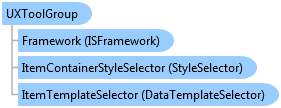

| Intersoft.Client.UI.Aqua Namespace : UXToolGroup Class |

<TemplatePartAttribute(Name="BorderElement", Type=System.Windows.Controls.Border)> <DescriptionAttribute("Represents a container that hosts a group of commands or controls, which can be used with toolbar or standalone.")> <StyleTypedPropertyAttribute(Property="ItemContainerStyle", StyleTargetType=Intersoft.Client.UI.Aqua.UXToolBarButton)> <TemplatePartAttribute(Name="RootElement", Type=System.Windows.Controls.Grid)> Public Class UXToolGroup Inherits Intersoft.Client.UI.Controls.Interactivity.ISDragableItemsControl Implements Intersoft.Client.Framework.IControl, Intersoft.Client.Framework.IFramework, Intersoft.Client.Framework.IItemsControl, Intersoft.Client.Framework.ILicensing, Intersoft.Client.UI.Controls.Interactivity.IDropable
Dim instance As UXToolGroup
[TemplatePartAttribute(Name="BorderElement", Type=System.Windows.Controls.Border)] [DescriptionAttribute("Represents a container that hosts a group of commands or controls, which can be used with toolbar or standalone.")] [StyleTypedPropertyAttribute(Property="ItemContainerStyle", StyleTargetType=Intersoft.Client.UI.Aqua.UXToolBarButton)] [TemplatePartAttribute(Name="RootElement", Type=System.Windows.Controls.Grid)] public class UXToolGroup : Intersoft.Client.UI.Controls.Interactivity.ISDragableItemsControl, Intersoft.Client.Framework.IControl, Intersoft.Client.Framework.IFramework, Intersoft.Client.Framework.IItemsControl, Intersoft.Client.Framework.ILicensing, Intersoft.Client.UI.Controls.Interactivity.IDropable
[TemplatePartAttribute(Name="BorderElement", Type=System.Windows.Controls.Border)] [DescriptionAttribute("Represents a container that hosts a group of commands or controls, which can be used with toolbar or standalone.")] [StyleTypedPropertyAttribute(Property="ItemContainerStyle", StyleTargetType=Intersoft.Client.UI.Aqua.UXToolBarButton)] [TemplatePartAttribute(Name="RootElement", Type=System.Windows.Controls.Grid)] public ref class UXToolGroup : public Intersoft.Client.UI.Controls.Interactivity.ISDragableItemsControl, Intersoft.Client.Framework.IControl, Intersoft.Client.Framework.IFramework, Intersoft.Client.Framework.IItemsControl, Intersoft.Client.Framework.ILicensing, Intersoft.Client.UI.Controls.Interactivity.IDropable
UXToolGroup is an items control that derives from ISItemsControl class, which means that UXToolGroup can contain and display a collection of objects. You can display a collection of UIElement through the Items property, or a collection of data entity through the ItemsSource property.
You can use UXToolGroup in two key scenarios, as a standalone control or as the item of UXToolBar.
UXToolGroup is commonly used as the item of UXToolBar which serves as the logical groups that host a collection of commands in the tool bar. In this case, UXToolGroup uses a lookless theme by default, allowing the groups to blend properly with the appearance of the tool bar, such as the Background, BorderBrush and others.
There are several advantages to use UXToolGroup in the tool bar, such as placing each group in different position and customizing the overflow setting for each group.
The following example shows how to create a UXToolBar with two UXToolGroup instances.
| XAML |
Copy Code
|
|---|---|
<Intersoft:UXToolBar> <Intersoft:UXToolGroup> <Intersoft:UXToolBarButton Content="Save Changes" DisplayMode="ContentAndImage" Icon="/Assets/Images/Commands/Save.png" Command="{Binding Path=SaveCommand}" /> <Intersoft:UXToolBarButton Content="Cancel" DisplayMode="ContentAndImage" Icon="/Assets/Images/Commands/Cancel.png"/> </Intersoft:UXToolGroup> <Intersoft:UXToolGroup Placement="RightOrBottom"> <Intersoft:UXToolBarButton Content="Help" DisplayMode="Image" Icon="/Assets/Images/Commands/Help.png" /> <Intersoft:UXSeparator/> <Intersoft:UXToolBarButton Content="More Actions" ButtonType="DropdownButton"> <Intersoft:UXMenuItem Header="Schedule a meeting" /> </Intersoft:UXToolBarButton> </Intersoft:UXToolGroup> </Intersoft:UXToolBar> |
|
The result looks like the following figure.

For more information on how to use UXToolGroup along with UXToolBar, see UXToolBar Overview.
For more information about UXToolGroup and its features, see UXToolGroup Overview.
System.Object
System.Windows.DependencyObject
System.Windows.UIElement
System.Windows.FrameworkElement
System.Windows.Controls.Control
System.Windows.Controls.ItemsControl
Intersoft.Client.Framework.ISItemsControl
Intersoft.Client.UI.Controls.Interactivity.ISDragableItemsControl
Intersoft.Client.UI.Aqua.UXToolGroup
Target Platforms: Windows 7, Windows Vista SP1 or later, Windows XP SP3, Windows Server 2008 (Server Core not supported), Windows Server 2008 R2 (Server Core supported with SP1 or later), Windows Server 2003 SP2